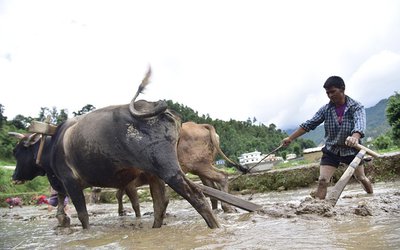Even as the entry of invasive insects and plants is sending the alarm bell ringing for Nepal's agriculture sector, the country's only direct air entry point for the outside world, that is, the Tribhuwan International Airport (TIA), is smug in doing its business as usual, without bothering much about the quarantine mechanism in place.
The TIA's sole focus at the moment seems to be on the yellow metal being smuggled in growing quantities and frequencies. As the airport authorities are deeply into the illegal gold hunt, no one seems actually concerned about the possibility of the alien species entering the country.
There are laws and regulations on checking the entry of alien species. But the customs officials hardly care to implement them. Quarantine authorities are rarely asked to check whether any new plant is coming through the regular TIA channel.
With more than 1500 kilometers of open land border, various species of plants and insects are moving between Nepal and India. Except culling illegally imported chicken from time to time, the authorities have no clue about the entry of other contraband species.
As a result, invasive species are entering Nepal from many directions. “At a time when the legal institutions are weak and the awareness level of people on invasive species is non-existent, Nepal is living under a constant threat of invasion of alien species,” said Dr. Tek Bahadur Gurung, senior scientist at Nepal Agriculture Research Council. “Fish and other aquatic species are under a direct threat of invasion from alien species.”
Outbreak of Disease
Known as a pocket area for commercial farming of cauliflower, tomato and other vegetables, Duwakot, Bode and Changu of Bhaktapur district have been producing good amounts of vegetable, helping the poor farmers improve their livelihood a lot.
However, the cauliflowers in these farms have started to dry at the time of harvesting this year as have the tomatoes. When the farmers rushed to the District Agriculture Office for technical help to ward off the danger, it was already late.
The yield of tomato planted in Dharmasthali and other parts of Tarakeshwor Municipality has similarly declined in comparison with that of the past years. After a study, scientists from Nepal Agriculture Research Foundation ascertained the reason: the pests were Tuta Absoluta, deadly germs, which fed on tomato leaves, fruits, and stems in Nepal. First reported in May 2016, Tuta Absoluta is a major threat for tomato farmers of Nepal.
The first record of occurrence of this pest in Nepal had been reported from the tomato farm of Tarakeshwor Municipality by Senior Scientist Ajaya Shree Ratna Bajracharya and his team from the Entomology Division of NARC.
A survey conducted within Kathmandu valley and its vicinity showed this pest had been spreading from Kathmandu valley into surrounding areas in Lalitpur, Bhaktapur, Kavrepalanchowk and Dhading districts.
According to scientists, Tuta Absoluta devastates tomato. This pest associated with solanaceous crops can reduce yield and quality of tomato in newly invaded areas, 80-100%, both in field and greenhouse conditions, if control measures are not applied.
The risk is not limited to a few farms. Nepal’s forest sector is under threat from such invasive plants. A more immediate menace, threatening the people, flora, and fauna in the region, is a bright green flowering vine, named Mikania micrantha, which is smothering everything in its path so aggressively that by 2010 it had covered at least one-fifth of the Chitwan National Park.
Not only the local species on land, the native fishes in the river are also facing invasion from the new fishes released into water, one way or the other, by the people. In a recently concluded International Conference on biodiversity, climate change assessment and impacts on livelihood, scientists and scholars presented an alarming scenario created by this movement of alien species.
Scientists revealed that the invasive species are the top threat to Nepal's biodiversity because of their negative effects on flora and fauna, food web, ecosystem and habitat. Their inherent capability to adjust in a wide range of environmental conditions and spread at higher pace with economic activities like travel, trade and tourism have necessitated a concern for their prevention and protection.
This has been recognized by the Convention on Biodiversity that calls the contracting parties to prevent introduction and control or eradication of invasive species. Nepal as a signatory to this convention has to take essential legal and managerial actions to abide by the convention.
Institutional Lapses
There are laws, regulations and institutions to deal with the invasive species. There is an institution to see if plants and species entering Nepal need quarantine. Institutions have been set up at the national and local levels under different acts, regulations and guidelines to control and eradicate the alien species. But they are far from enforced.
With increased globalisation and commercial long distance travel and trade, species are transported across space and time, with some of them invading the new surroundings. As a result, hundreds of new organisms are coming to Nepal every year.
Invasive species are a worldwide problem. The increase in travel and open trade routes and breaking of old bio-geographic barriers are partly responsible for the problem. Approximately, 42 percent of the world’s threatened or endangered species are at risk due to the alien invasion.
Invasive species disrupt ecosystem and threaten diversity. In Nepal, it may cost millions of rupees per year to deal with the situation. Scientists argue that for a country like Nepal, prevention is better than cure.
“Approximately 42 percent of the world's threatened or endangered species are at risk due to invasive species. Invasive species disrupt the ecosystem and threaten species diversity. Biological control should be considered."
But it is easier to prevent the risk of invasion through research, education and enhanced regional collaboration.
For Nepal, it is important to focus on the development of a specific national strategy and coordinated plan, better information on the control of invasive species, increasing the level of research, surveys and investigation, improved regional level coordination with neighbors, seeking a more reliable financial support for insecticide management. There is the need to develop a dedicated institutional framework and develop regulations, education programs, invasive species lists, and a national society.
Biological control of invasive species requires the use of a living organism to control the invasive species. This organism may eat the invasive species or cause it to become diseased. Potential agents must be carefully assessed before release to ensure the control species will not become invasive.
“Biological invasions and climate change are among the five major causes of global biodiversity loss. International commerce and travel have moved species within and between continents, to areas where they could not have reached on their own, and climate change has aided their establishment and further spread within the introduced range. There is a big threat to invasive alien plant species in Nepal. Invasive plant Mikania micrantha has already invaded rhino habitat of Chitwan National Park,” said Steve W Adkins of University of Queensland Australia. "Preventing new biological invasions or tackling them at a very early stage is the most effective approach."
Controlling the insects and plants is always costly. “Fire ant entered Australia twenty years ago and created havoc to local species. To eradicate the ant, 629 staff were employed and 150 million Australian dollars spent. This included aerial detection and low toxic bait treatment,” said Adkins.
As the threat to Nepalese livelihood intensifies due to the loss of biodiversity and impacts of climate change, there is an urgency to take better actions and initiatives. Given Nepal’s current situation, all stakeholders, government officials, scientists, academic institutions, development partners and civil society members will need to come together to discuss bio-diversity, climate change assessment and impacts on livelihood.
“The scientists have raised three main issues -- control emerging epidemic of Tuta Absoluta, share knowledge to prevent the entry of new species of mice, and implement environmental service charges. As biodiversity of Nepal protects the whole ecosystem of the world, there is the need to provide service charge for it,” said Professor Dr. Pramod Kumar Jha, co-host of the International Conference on Biodiversity, Climate Change Assessment and Impacts of Livelihood.
“This is for the first time all stakeholders, including ministries, academic institutions, scientists and Nepal’s development partners have come together in a platform to discuss the climate change and its implications.”
Organised by Central Department of Botany, TU, Agriculture and Forestry University, USAID/IPM Innovation Lab, CUNY, IGATT, the gathering brought world-renowned scientists from Australia, United States of America, India, Bangladesh and Nepal to share their research findings. Over 350 participants, including over 100 participants from abroad, actively participated in the conference.
“Climate uncertainty and human needs for nutrition and income provide strong incentives for us to seek solutions to agriculture and community problems. Smart use of water, soil, and nutrients requires the creation and adoption of innovative changes. As scientists and educators, we must understand local production methods and social constraints before testing changes,” professor Shock C. Clinton, Oregon State University, said. “Based on local production methods, we creatively imagine various options to provide feasible solutions.”
Biodiversity has been an important subject of research and global discourse since the Convention on Biological Diversity, as it forms the basis of people’s life and livelihoods. Biodiversity is closely linked to climate, culture and conservation efforts.
“Protecting the unique assemblage of biodiversity together with meeting the needs of people under the scenario of climate change remains a great challenge. Climate change has emerged as one of the most important environmental, social and economic issues today. The impacts are most severe for the global poor and South Asia is one of the regions highly affected by these changes,” said Professor Jha.
From invasive plants to pets and water depletion to change of precipitation, Nepal will have to face major challenges in overall livelihood, particularly food security. The discussion and sharing of knowledge by scientists and various agencies can be expected to help Nepal in the future.
International commitment
Nepal is signatory for CBD, and has developed the national biodiversity strategy and national biodiversity implementation plan; where it has opened the door for making the rules and site specific plans to conserve biodiversity. Secondly, Nepal is a member of CITES; so there is a strict law on export-import of the plants and animals enlisted in appendices of CITES. Both managerial and scientific units are established to strictly implement the law. Thirdly, global organizations like IUCN and WWF are working for the protection and prevention of local environment, such as in CNP, from invasive species, implementing various projects from grass root level to park level.
Legal provisions
Nepal has some acts to create conducive working environment for protecting and preventing the spread of invasive species. Forest Act 1995 is one of them. The act has enlisted some species as banned for export and import without taking sanction from government.
This act also has enlisted some species as protected, for them special management plans are implemented and any harmful activities regarding sustainability and existence to them are highly prohibited.
National Park and Wildlife Conservation Act 1973 focuses on maintaining the in situ environment to conserve biodiversity by establishing various protected areas.
Out of them, the most important legal instrument in support of protection and prevention from invasive species is ‘Plant Protection Act 2007 and Plant Protection Rules 2010’.
Both have provisions to form a committee at the national level to provide comments and suggestions for government on policies of plant and plant products quarantine.
According to this act, an entry permit has to be earned if anybody wishes to import plants, plant products, biological control agents, beneficial organisms or means of growing plants such as soil, moss and pit.
According to the act, the government can restrict the import of any specimen belonging to any species at any time without prior notice. There is a provision, which requires obtaining Phyto-sanitary certificate while making export and re-export. If any person or anybody intends to carry any consignment of plant and plant products or other articles in transit to another country via the route of Nepal, such person should obtain carriage consignment permit earlier.
For the purpose of making inspection of plants, plant products, biological control agents, beneficial organisms or other articles, the government may designate any employee who possesses the prescribed qualifications, as inspectors to inspect anywhere and anytime. There is a provision of penalties, too.
As Nepal’s connectivity has increased, laws and institutions alone, however, are not enough. What is required is more vigilance at all levels, from that of farmers to officials, in preventing the entry and invasion of foreign species. Nepal cannot afford to wait and cure the disease caused by the invasive species, as this will be far costlier than prevention.

Keshab Poudel
Poudel is the editor of New Spotlight Magazine.
- FOURTH PROFESSOR Y.N. KHANAL LECTURE: Nepal-China Relations
- Jun 23, 2025
- Colonel JP CROSS: Centenary Birthday
- Jun 23, 2025
- REEEP-GREEN: Empowering Communities with MEP
- Jun 16, 2025
- BEEN: Retrofitted For Green
- May 28, 2025
- GGGI has been promoting green growth in Nepal for a decade: Dr. Malle Fofana
- May 21, 2025















